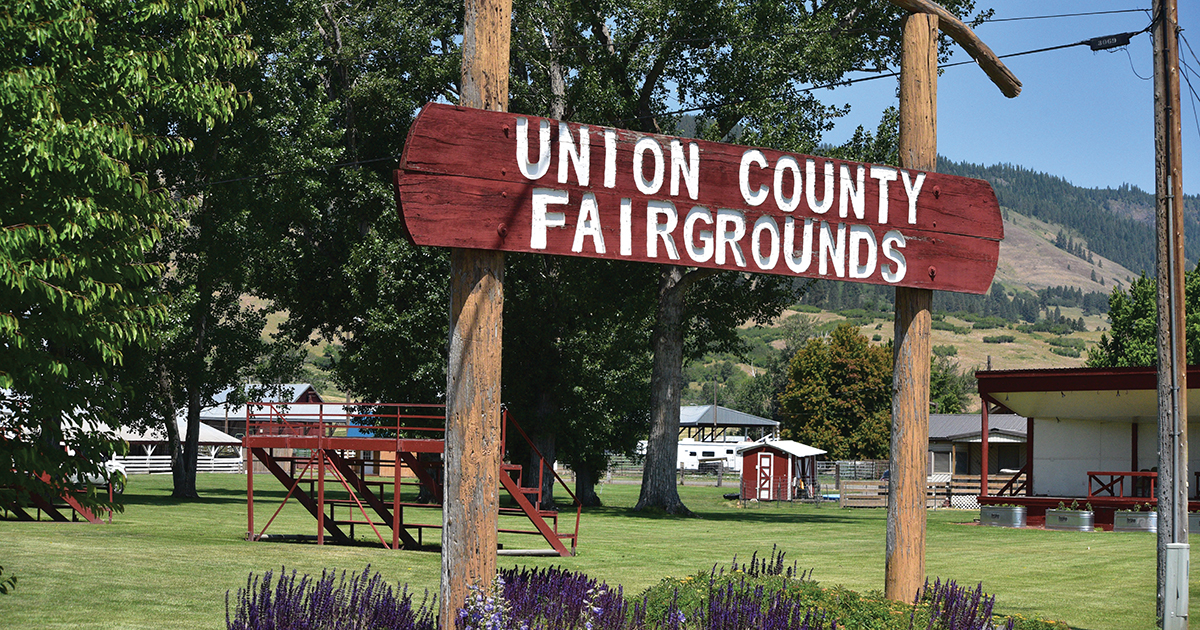ADVANCES IN IRRIGATION TECHNOLOGY BOON TO GRANDE RONDE FARMING
Published 12:00 am Monday, August 16, 2004

- Water wheels: Spray from these sprinklers water Grande Ronde alfalfa in the cool morning air. (Photos by Mardi Ford).
Part one of three
Trending
Editor’s Note: Today’s Ag/Life section features the first of a three-part overview of irrigation a subject as complex as the crooked channel of the Grande Ronde River. Part two will focus on pivot irrigation. Part three will focus on linear irrigation and conservation practices.
By Mardi Ford
Staff writer
Trending
Third generation farmer Brett Rudd’s face is serious as a heart attack his tone is matter-of-fact.
"Water is everything," he says. And he should know. Rudd just had a well drilled on his farm located in one of the sandiest areas of the valley.
They went down 350 feet at about $100 a foot, Rudd says.
Ironically, as he talks about water he fills a large tank on his flat bed with water from a garden hose.
After almost 200 years of farming in the Grande Ronde Valley, there is one thing that has not changed water is still everything.
Like others settling the new frontier, during the 1800s pioneers in the Grande Ronde Valley found a much drier climate than many of them left behind in the East. They soon discovered that water was life.
Fledgling communities sprang up near rivers, lakes, springs, streams and other naturally occurring sources of water. It was no different in the early days of the Grande Ronde River Valley and the people who chose to live here.
Although the early days of agriculture in Union County centered more around dryland farming, the Grande Ronde River, Catherine Creek and their tributaries as well as the valley’s many creeks, streams, sloughs, brooks and springs all provided means for flood irrigation.
Unfortunately, flood irrigation was often unpredictable and highly inefficient, but it was the way to irrigate for decades.
Dryland farming unpredictable
In the late 1940s, Creston Shaw was a young farmer. He had started out as many did in those days, farming dryland on rented ground with his own family as hands. Dryland farming, Shaw says, was also unpredictable.
"The first year, you’d plant and get a good crop," he recalls. "The second year it would be a fair yield, the third poor."
Shaw remembers the difference pump irrigation made to his own crop yields after he began to use a diesel engine to pump river water through irrigation pipes.
"It meant you could bank on a good crop," he says, "for expansion or borrowing for the next year."
His first pump was a diesel engine he bought, along with some used valves and pipe, from a scrap yard in Portland. The engine had come off a liberty ship, the "workhorses" of World War II and the largest class of civilian-made warships ever built.
Like most local farmers at that time, Shaw knew little about hydraulics, water flow or pump irrigation, but was willing to learn. During the winter, he took classes from Oregon State University. He gained experience and expertise through trial and error, putting what he learned in school to use on the farm.
The diesel engine had been designed to pump 1,000 gallons of water a minute as a firefighting tool on the ship. With, Shaw’s irrigation lines handling 250 gallons each, he could run four lines off the diesel engine’s pump.
River water was flowed through a conveyance system of steel pipe called main lines to a sprinkler system called hand lines.
Each of Shaw’s hand lines are comprised of 33 40-foot aluminum sections of pipe with sprinkler heads attached every 40 feet. Each sprinkler covers an area of about 60 feet. One hand line could cover one-quarter acre of previously dry land with water.
The down side to all this is the labor-intensive process of moving pipe.
First, the sprinkler system is drained, then disassembled into sections and hand carried to the next section of field needing watered.
Then, the sections of aluminum pipe are reassembled at the joints and carefully aligned in straight rows.
Shaw looks back to the days when he and his family would change hand lines in the dark.
"We’d start at one edge of the field and my daughter would stay there with a flashlight," he recalls. "Then I’d just keep an eye on that flashlight, line myself up with that and work my way across."
Once the lines are assembled and set, the water is turned back on. Each joint has a gasket that seals under the pressure of the water flow, then opens after pipes drain.
"Different manufacturers make different joining systems," Shaw says, "and some easier to fit together than others."
Although pumps and hand lines made irrigation accessible to more fields, Shaw says farmers could still irrigate only as much land as they had time to move hand lines. Shaw would spend an hour to an hour-and-a-half every evening just changing four hand lines.
"Then in the 1960s," he recalls, "I began to hire some boys from town to come out and move sprinklers for me at 5 cents a pipe."
Historic change
It was at about that same time, Shaw says that something historically significant happened with regards to irrigation in the Grande Ronde Valley.
"The electric company came along and offered to build power lines for the farmers at a minimal charge," he recalls. "They offered us a rate of less than two cents per kilowatt."
For a farmer like Shaw who was using 100 gallons of diesel per day at 18 to 30 cents a gallon, the offer meant substantial savings.
"That’s when irrigation really took off," he adds.
Though the technology of wheel line systems had been around a while, with the advent of cheaper power in the 1960s, they began to appear in the valley more and more.
Motorized wheel lines are significantly less labor-intensive than hand lines. However, they still have to be stopped, drained, disconnected from a riser on the mainline, moved, reconnected to the next riser on the mainline and powered up again.
The newest wheel line motors come equipped with transmissions capable of moving at a speed of one foot per minute up to as much as 60 feet per minute or more. This allows the farmer to slog out of a muddy area without burning up the motor, then speed up over dry ground.
The entire set acts as a giant axle," says engineer Rod Sands. "They provide enough torque to produce a twisting motion clear to the end."
Today, wheel lines are still the primary method of irrigation used in Union County.









